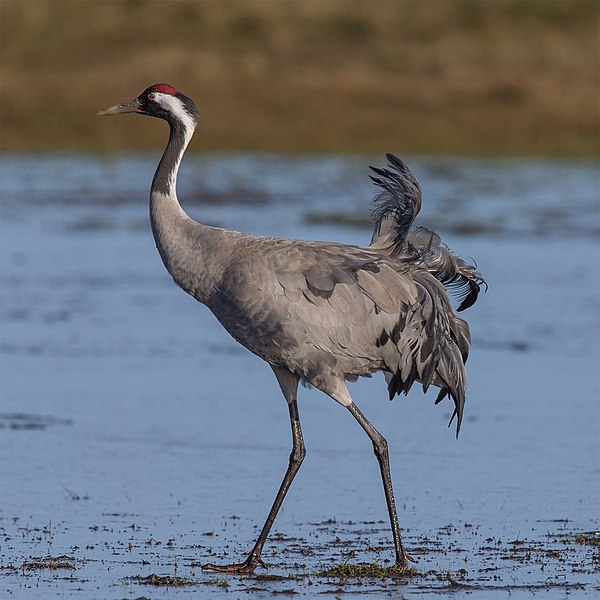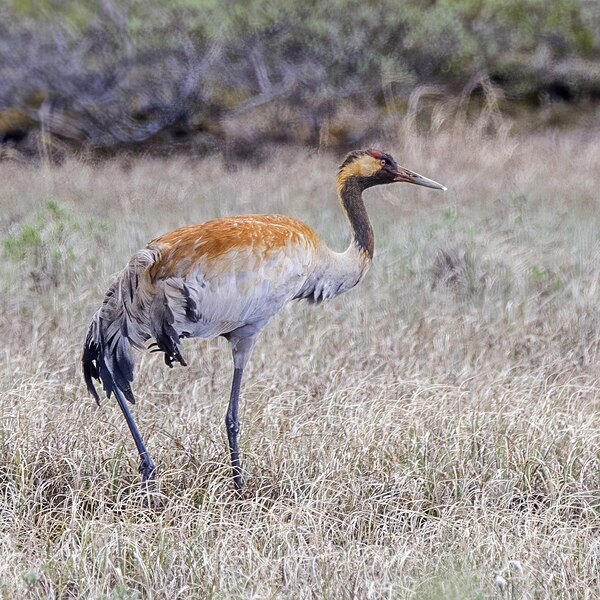Common cranes (Grus grus) are tall, long-legged birds with a wingspan of up to 2.4 metres and a height of approximately 1.2 metres. They have predominantly grey plumage, black flight feathers, and a distinctive ruby-red patch on their heads. Like most bird species, they are omnivorous, feeding on a varied diet of plants, insects, amphibians, and small vertebrates. As of 2015, their global population was estimated at between 491,000 and 503,000 individuals, with the majority breeding in Russia, Finland, and Sweden.
One of the most iconic aspects of crane behaviour are their synchronised courtship displays of dance and amorous calling songs. These rituals reinforce pair bonding, as common cranes, like many large, slow-breeding birds, mate for life. This is also typical among many long-lived species where cranes can live up to 40 years of age. They are highly migratory birds, with populations breeding in northern Europe and western Asia before migrating to southern Europe and Africa for the winter.
The common crane was once a common sight in Britain’s wetlands. However, by the early 1600s, the species had almost completely disappeared due to extensive drainage of marshlands for agriculture and relentless hunting, both for food and for use in ceremonial feasts. Owing to their already low populations, they were seen as luxury delicacies and prized particularly during Lent where they were considered ‘fish’ under medieval catholic dietary rules. This view of them as symbols of high status thus plummeted their final numbers into near complete extinction across the British Isles by the 17th century.
Following centuries of absence, in 1979 a small breeding colony was discovered in the wetlands of the Norfolk Broads. As an already declining habitat affecting many other vulnerable species such as the iconic curlew, this inspired conservationists into action. Over the following decades, conservation organisations such as the RSPB, the Wildfowl & Wetlands Trust (WWT), and Natural England launched initiatives to help the crane population recover.
One of the most significant projects was the Great Crane Project, launched in 2010. This initiative aimed to boost Britain’s crane population by releasing captive-reared birds into suitable habitats. Using techniques developed in Germany, young cranes were hand-reared at WWT Slimbridge and then released in the Somerset Levels and Moors, a landscape carefully managed to provide ideal breeding conditions. Over several years, dozens of cranes were released, and many successfully established breeding territories.
Today, Britain’s common crane population stands at over 200 individuals, with breeding populations in Norfolk, Suffolk, Cambridgeshire, Somerset, Gloucestershire, and parts of Wales. The success of reintroduction efforts has led to an increase in both the number of breeding pairs and the geographic range of the species. These birds are now successfully raising chicks in areas where they had been absent for centuries.
As previously mentioned, wetland conservation has played a crucial role in the resurgence of and protection of bird species. By restoring traditional wetlands and creating new reserves, conservation groups have provided crucial nesting and feeding grounds. Sites such as the RSPB’s Lakenheath Fen and the WWT’s Welney Wetland Centre have been instrumental in supporting the species’ recovery.
Despite their remarkable comeback, common cranes are still incredibly vulnerable and are faced with the common plethora of modern ecological challenges. Habitat destruction due to agriculture and urban development remains a concern, as cranes require large, undisturbed wetland areas for breeding and feeding.
A lack of general education and awareness also leaves their delicate breeding conditions at risk to even the lightest of human activities of recreation, traffic and noise pollution. These factors often cause long-term breeding failures in a species already suffering from low reproductive rates (largely known as K-breeding strategy).
Species of this slow breeding pattern compensate with high parental investment, dedicating significant time and resources to raising their young. They typically have long lifespans, often living for decades, which allows for multiple breeding opportunities despite their slow reproduction. These species also reach sexual maturity late, taking years before they can reproduce. While their populations remain stable in undisturbed environments, they are particularly vulnerable to habitat loss and overexploitation. Humans are one such species.
The return of the common crane to Britain is a remarkable conservation success story. From complete extinction in the 17th century to a small but tentatively growing population today, the efforts of conservationists, land managers, and the public have made a significant impact.
With ongoing and continued efforts the loving courtship calls of common cranes may once again echo across Britain’s wetlands for generations to come!

Common Crane Adreas Trepte

An adult crane in flight.

A juvenile crane developing adult plumage.
